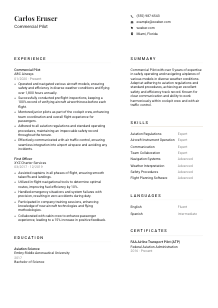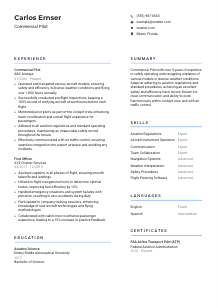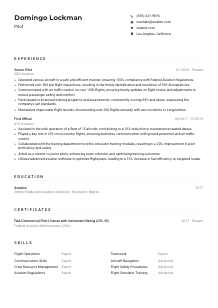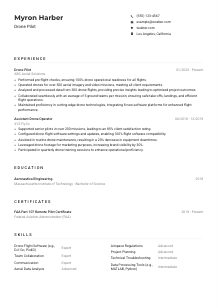Commercial Pilot CV Example
Navigating the skies, but your CV feels grounded? Take off with this Commercial Pilot CV example, mapped out using Wozber free CV builder. It illustrates how you can sync your aviation expertise precisely with job guidelines, ensuring your career trajectory remains as smooth as a well-timed ascent!

How to write a Commercial Pilot CV?
Gear up, aspiring Commercial Pilot! Are you ready to navigate the job market with a CV that truly soars above the rest? Crafting a CV that lands you in the cockpit requires more than just listing flight hours; it's about showcasing your expertise, skills, and passion for the skies.
Using Wozber free CV builder, we'll guide you through creating a CV that's not only ATS-compliant but also tailored to lift your career to new altitudes. Let the journey to crafting your perfect Commercial Pilot CV begin!
Personal Details
Your personal details section is your beacon in the night sky, guiding recruiters to know who you are. While it seems straightforward, it's crucial to fly this part with precision. Ready to take off? Here's how to make your personal details shine bright.
1. Captain Your Name
Your name is your call sign in the job market, so make it memorable. Use a clear, bold font that ensures your name stands out, setting the stage for the rest of your CV.
2. Cleared for Commercial Pilot Position
"Commercial Pilot" – seeing this title below your name instantly aligns your CV with the job you're applying for, making it easier for recruiters to see you're targeting the role with purpose.
3. Ensure Your Contact Radar is Clear
Include your most reliable phone number and a professional email address. Stick with a format that's simple yet professional, like firstname.lastname@email.com, ensuring there's no interference in communication.
4. Location Lock
"Must be located in or willing to relocate to Miami, Florida." Broadcasting your Miami, Florida, location upfront meets one of the job's logistical needs, promising a smooth flight path in the hiring process.
5. Online Presence - Your Virtual Hangar
A LinkedIn profile or a personal website can serve as a virtual hangar for your achievements and certifications. Make sure it's polished and up-to-date, reflecting your dedication to the aviation community.
Takeaway
Brilliant! With your personal details finely tuned, you've successfully completed your first pre-flight checklist. These details set the altitude for the rest of your CV journey. Remember, the goal is to ensure a smooth and clear introduction, aligning perfectly with the Commercial Pilot role.





Experience
Your experience section is where you fly high, showcasing your flight expertise and achievements. It's not just about logging hours; it's about demonstrating how those hours have prepared you for this particular cruise altitude. Prepare for takeoff as we navigate through crafting an experience section that highlights your qualifications for the Commercial Pilot position.
- Operated and navigated various aircraft models, ensuring safety and efficiency in diverse weather conditions and flying over 1,800 hours annually.
- Successfully conducted pre‑flight inspections, keeping a 100% record of verifying aircraft airworthiness before each flight.
- Mentored junior pilots as part of the cockpit crew, enhancing team coordination and overall flight experience for passengers.
- Adhered to all aviation regulations and standard operating procedures, maintaining an impeccable safety record throughout the tenure.
- Effectively communicated with air traffic control, ensuring seamless integration into airport airspace and avoiding any incidents.
- Assisted captains in all phases of flight, ensuring smooth takeoffs and landings.
- Utilized in‑flight navigational tools to determine optimal routes, improving fuel efficiency by 10%.
- Handled emergency situations and system failures with precision, resulting in zero accidents during duty.
- Participated in company training sessions, enhancing knowledge of new aircraft technologies and flying methodologies.
- Collaborated with cabin crew to enhance passenger experience, leading to a 15% increase in positive feedback.
1. Pre-Flight Inspection
Start by scrutinizing the job requirements. "Operate, maneuver, and navigate the aircraft safely," for example, calls for examples of previous flights where you've done exactly that. Highlighting experiences that match these requirements is crucial.
2. Log Your Flight Hours
Structure your experience by listing roles, companies, and dates worked. Prioritize recent and relevant positions where your responsibilities align closely with those listed in the job description, emphasizing your role as a navigator of the skies.
3. Showcase Your Maneuvers
For each role, articulate your accomplishments that resonate with the job's needs. Highlighting experiences like "Operated and navigated various aircraft models, ensuring safety and efficiency" directly mirrors the job description, providing a clear example of your suitability.
4. Fly With Numbers
Whenever possible, quantify your achievements. If you've increased fuel efficiency or improved safety records, mention it, along with the specific outcome. Numbers offer tangible evidence of your impact in the cockpit.
5. Relevant Missions Only
Tailor your experience to the role. Every line should demonstrate that you're not just any pilot, but the right pilot for this job. Lesser relevant experiences can be left in the hangar to keep your CV streamlined and focused.
Takeaway
Great job! Your experience section now vividly narrates your journey, highlighting your qualifications for the Commercial Pilot role. Each bullet point is a testament to your skills and dedication to aviation. Ready for the next step? Let's climb higher!
Education
Your educational background is the runway that launched your career. While this jetway seems straightforward, strategically presenting your education ensures your CV makes a smooth landing in the recruiter's hands. Whether you're a fresh graduate or a seasoned flyer, let's ensure your education section elevates your candidacy.
1. Aligning Your Flight Plan
Identify the key educational requirements from the job posting. Although the example didn't highlight specific educational needs, including your aviation-related degree demonstrates a solid foundation in the field.
2. Education Flight Checklist
Format your education section for a quick scan by listing your degree, field of study, and the names of institutions, followed by graduation dates. This clear formation allows recruiters to easily see your educational journey.
3. Certify Your Flight Status
In cases where specific degrees are required, prominently display your relevant academic qualifications. For a Commercial Pilot, your Bachelor of Science in Aviation Science from Embry-Riddle showcases your specialized preparation for this role.
4. Enrich Your Educational Payload
While the main focus might be on your degree, consider mentioning relevant courses or training that add value to your candidacy, especially if they directly relate to skills mentioned in the job posting.
5. Honors and Extracurricular Climb
If you have graduated with honors or participated in pertinent clubs or projects, include these details to add another layer of credibility and interest to your profile. For senior positions, gauge the relevance of these achievements.
Takeaway
With your education section clearly outlined, you're signaling to hiring managers that you have the foundational knowledge and training necessary for a Commercial Pilot. This section validates your preparedness to handle the responsibilities that come with the role.
Certificates
In the aviation world, certifications are not just accolades; they're essential validations of your expertise and commitment to safety. The right certifications can set you apart, proving you're up-to-date with industry standards. Let's review how to present your certifications in a way that resonates with your dream Commercial Pilot position.
1. Highlight Essential Certifications
Your FAA Airline Transport Pilot (ATP) certificate is your clearance to the Commercial Pilot role. Ensuring this certification is front and center on your CV meets a critical requirement head-on.
2. Display Pertinent Credentials
Focus on certifications that are directly relevant to the Commercial Pilot's role, ensuring they're easily noticed. Remember, quality trumps quantity when it comes to showcasing your qualifications.
3. Valid Through
Include the date of issuance and, if applicable, expiration for your certifications. This transparency reassures recruiters of your credentials' current standing, cementing your reliability.
4. Continuous Learning Cruising Altitude
The aviation industry values lifelong learning. Regularly update your certifications and pursue new opportunities to learn. This commitment to continuous improvement signals to employers that you're always seeking to enhance your qualifications.
Takeaway
Your certifications act as a beacon, highlighting your readiness and eligibility for the Commercial Pilot role. This section should reassure hiring managers of your dedication to maintaining the highest standards in aviation safety and knowledge.
Skills
Think of your skills section as the instrument panel of your CV - each skill is a critical gauge of your professional capability. For a Commercial Pilot, this means balancing technical prowess with exceptional soft skills. Ready to calibrate your skills for a smooth career flight? Let's dive in.
1. Charting the Course
Start by decoding the job requirements. Skills like "Aviation Regulations" and "Aircraft Instrument Operation" are your VOR and ILS, guiding you through the ATS optimisation process with precision.
2. Match Your Skills with the Flight Plan
Lay out your technical and soft skills, prioritizing those that align with the job description. Your expertise in "Aviation Regulations" and proficiency in "Communication" and "Team Collaboration" are directly in line with the job's demands.
3. Skills Organized for Easy Navigation
Keep your skills section streamlined and focused. List the most relevant skills first, making sure they're easily identifiable at a glance. This strategic placement ensures that your most compelling qualifications catch the recruiter's eye.
Takeaway
With your skills finely tuned and displayed, your CV now provides a clear and concise panel, guiding the hiring manager through your professional aptitude. This section verifies your capa... and commitment to excellence, promising a smooth collaboration in the cockpit and beyond.
Languages
In the globally interconnected world of aviation, your ability to communicate in multiple languages can be a valuable asset. It's about tuning into the right frequency to ensure clear, effective communication with crew and passengers alike. Ready to broadcast your linguistic capabilities? Let's ensure they're clearly conveyed in your CV.
1. Tower, This is Job Applicant
Firstly, assess if the job posting demands specific language skills. In this role, "high proficiency in English" is a must, so leading with your fluency in English is non-negotiable.
2. Declare Your Language Payload
After English, list other languages you are proficient in. Your ability to communicate in multiple languages not only showcases your adaptability but also your readiness for diverse and international flight operations.
3. Be Specific with Your Proficiency Level
Use clear terms like "Fluent" and "Intermediate" to define your proficiency, establishing clear expectations about your communication capabilities.
4. Global Transponder Check
In the aviation field, additional languages can be a significant advantage, highlighting your potential for managing international flights or dealing with a diverse passenger list.
Takeaway
Showcasing your language skills does more than just verify your ability to communicate; it presents you as a global aviation professional ready for any route. Consider this section your personal transponder, signaling your linguistic range and versatility to potential employers.
Summary
The summary is your first opportunity to climb above the competition. It's here that you encapsulate your professional journey, honing in on what makes you the perfect candidate for the Commercial Pilot position. Ready to craft a summary that guarantees a smooth takeoff? Let's plot the course.
1. Assess the Flight Conditions
Review the job posting carefully to grasp the essence of what the employer is looking for. Your goal is to reflect these requirements in your summary, demonstrating your perfect alignment with the role.
2. Lift-Off
Start with a powerful opening that defines you as a professional. For example, "Commercial Pilot with over 5 years of expertise in safely operating and navigating airplanes." This sets the stage for your qualifications and passion for flying.
3. Altitude Adjustment
Pinpoint your standout skills and experiences that directly address the job's criteria. Your adeptness in "adhering to aviation regulations and standard procedures" and your "excellent safety and efficiency track record" are prime examples of this alignment.
4. Short and Sweet Climb
Keep your summary concise, aiming for 3-5 impactful lines. This isn't the place for the full journey but rather the highlights that entice hiring managers to read on.
Takeaway
With a compelling summary in place, you've crafted a strong opening for your CV, setting a confident trajectory toward the Commercial Pilot role. Think of this section as your runway: by clearly showcasing your qualifications and passion, you're cleared for a successful career takeoff.
Launching Your Commercial Pilot Journey
Congratulations! You've meticulously tailored your CV to align with the Commercial Pilot position, ensuring it's not just ATS-compliant but a true reflection of your expertise and commitment to aviation. Employ Wozber's free CV builder, ATS-friendly CV templates, and ATS CV scanner to fine-tune your application. Your CV is now a well-crafted flight plan, ready to guide you to your next destination in the aviation industry. Buckle up and prepare for landing in your dream role. The skies await your brilliance!

- Minimum of 1, 500 hours of total flight time, with preferred experience in multi-engine aircraft.
- Must possess a valid FAA Airline Transport Pilot (ATP) certificate.
- Exceptional communication and collaboration skills, with the ability to work effectively within a team and with air traffic control.
- In-depth knowledge of aviation regulations, navigation and weather systems.
- Proficiency in operating and interpreting aircraft instruments and systems.
- The role demands high proficiency in English.
- Must be located in or willing to relocate to Miami, Florida.
- Operate, maneuver, and navigate the aircraft safely and efficiently in all weather conditions.
- Ensure pre-flight inspections are conducted to verify the aircraft is airworthy before each flight.
- Maintain a thorough understanding of all standard operating procedures and adhere to them at all times.
- Communicate effectively with ground control, air traffic control, and cabin crew to ensure a safe and smooth flight.
- Regularly attend professional development and training courses to stay updated with the latest industry standards and procedures.















